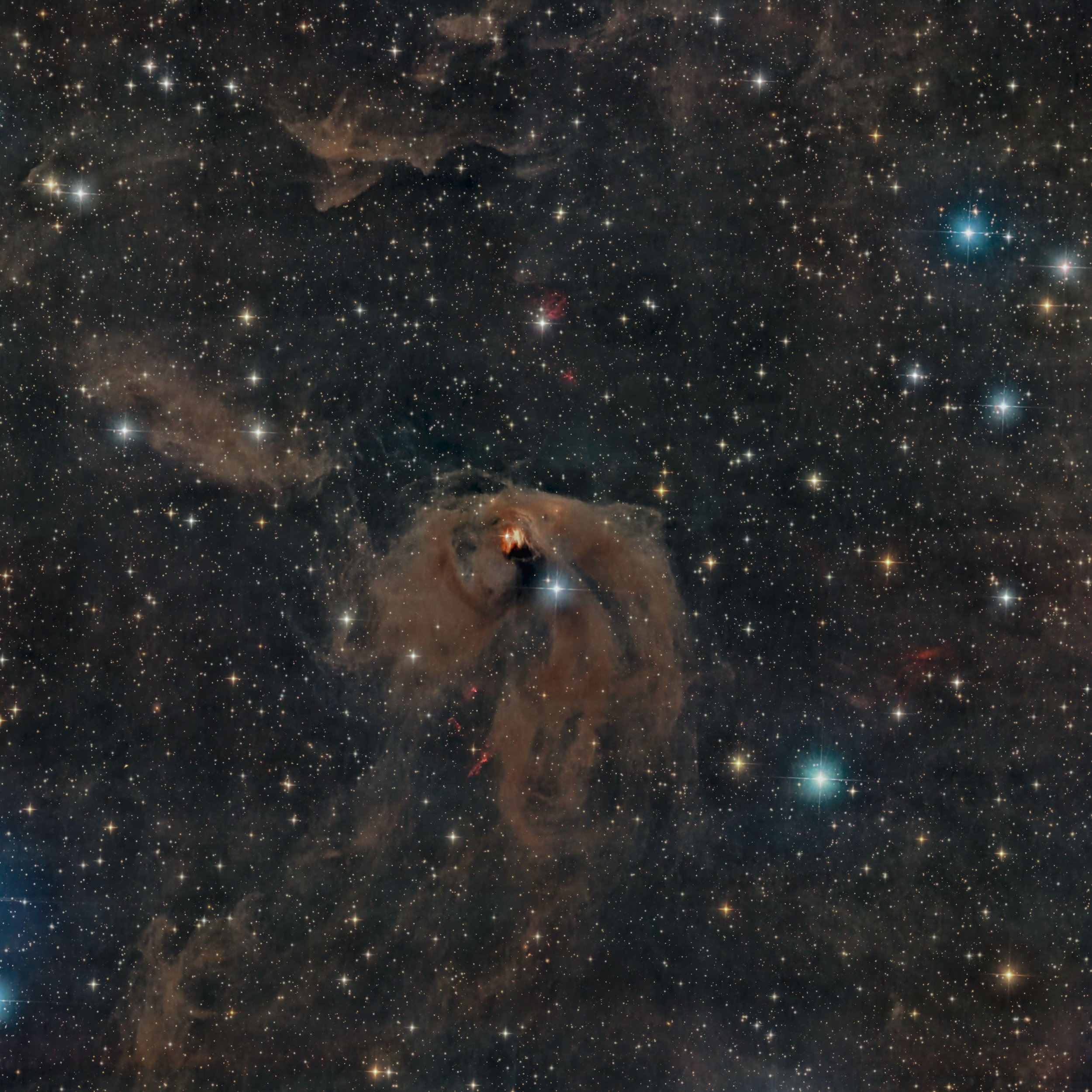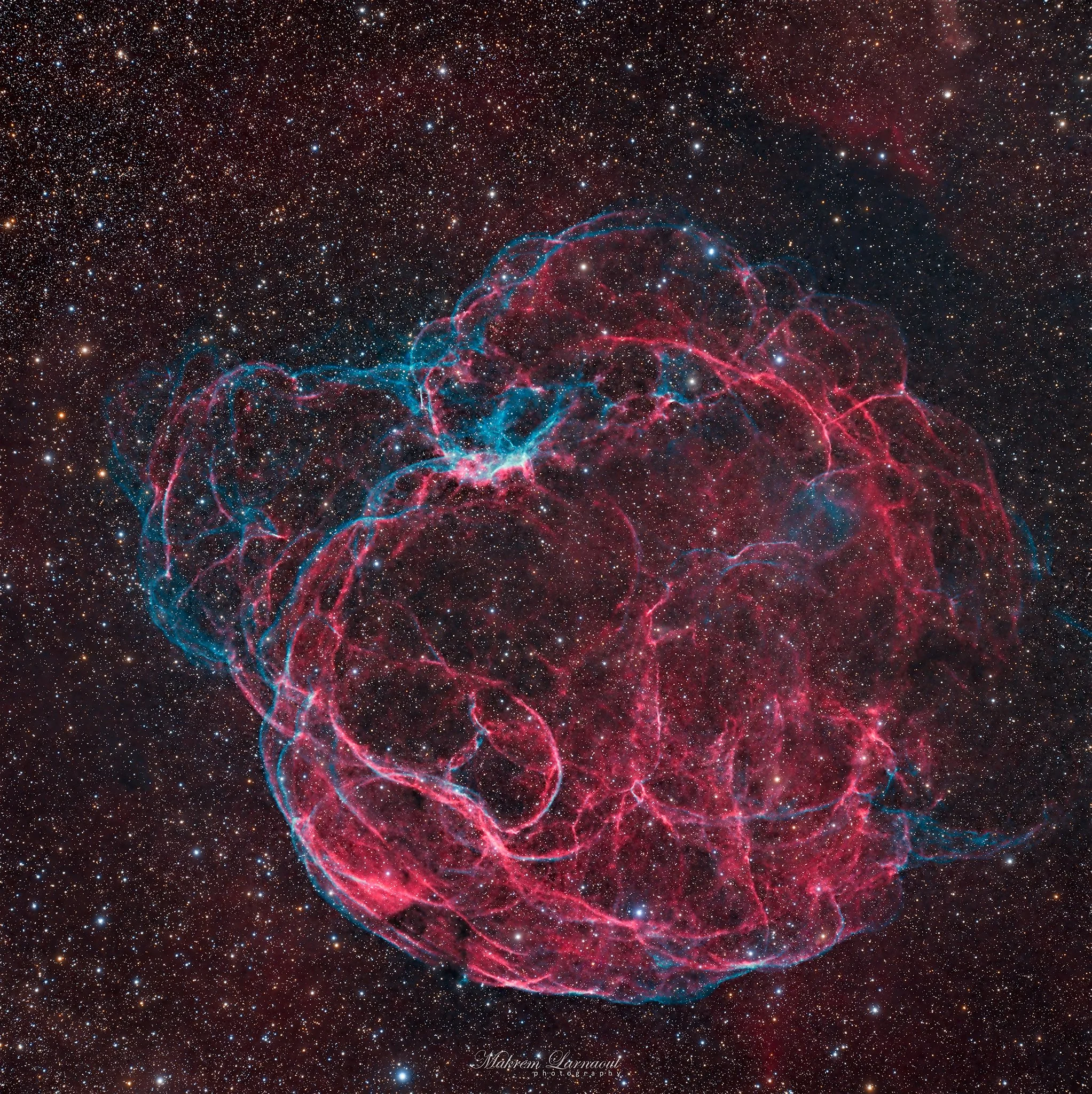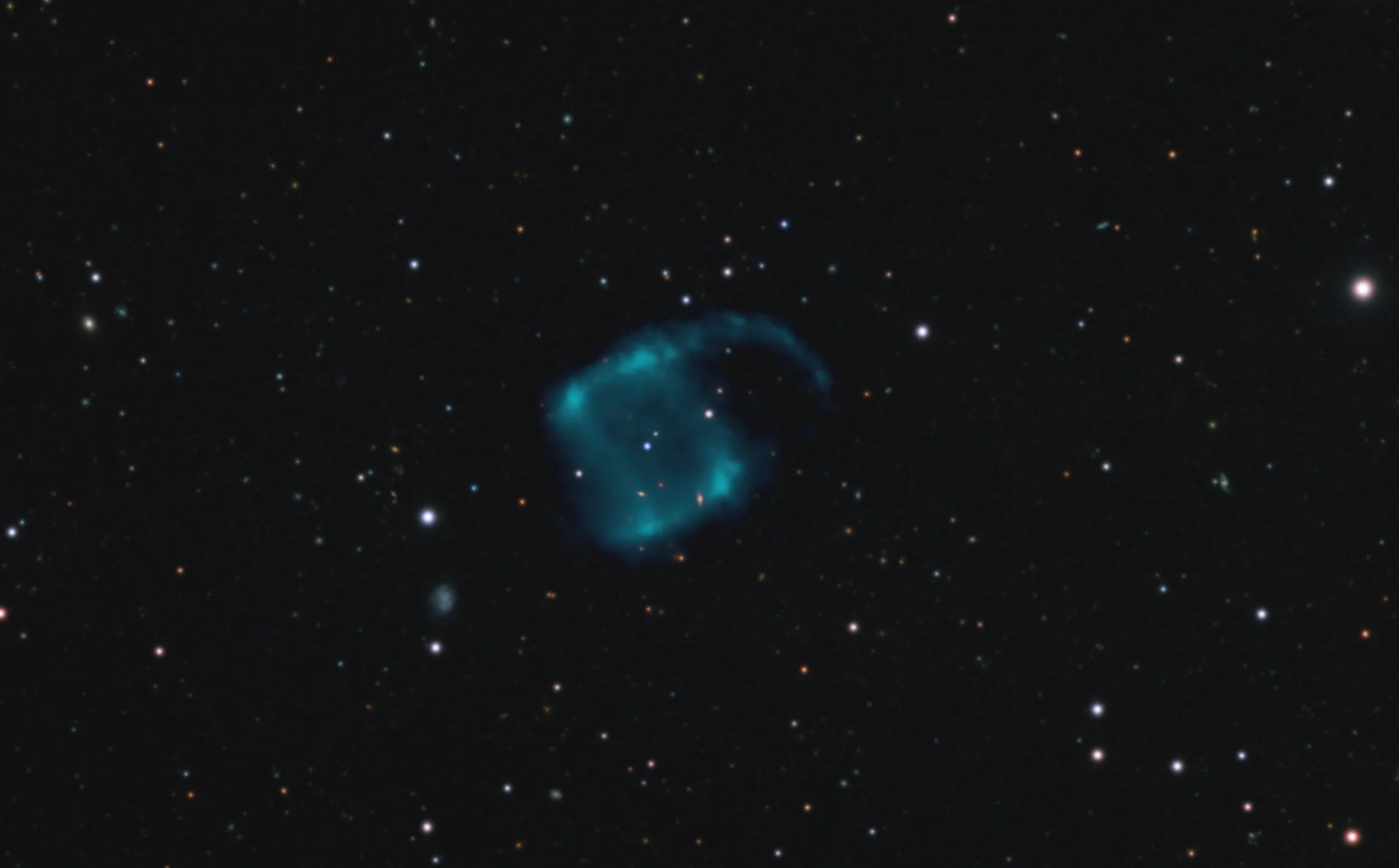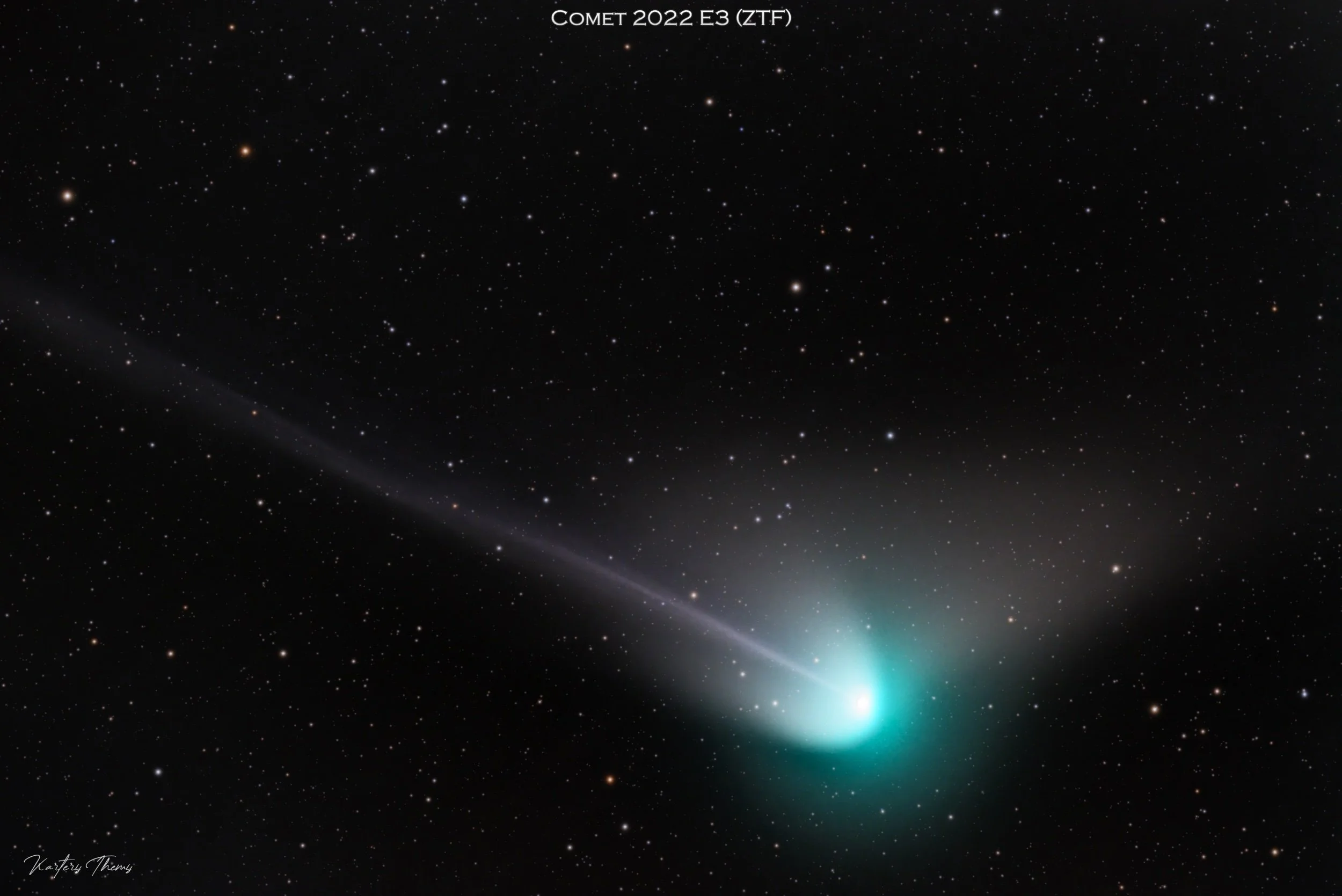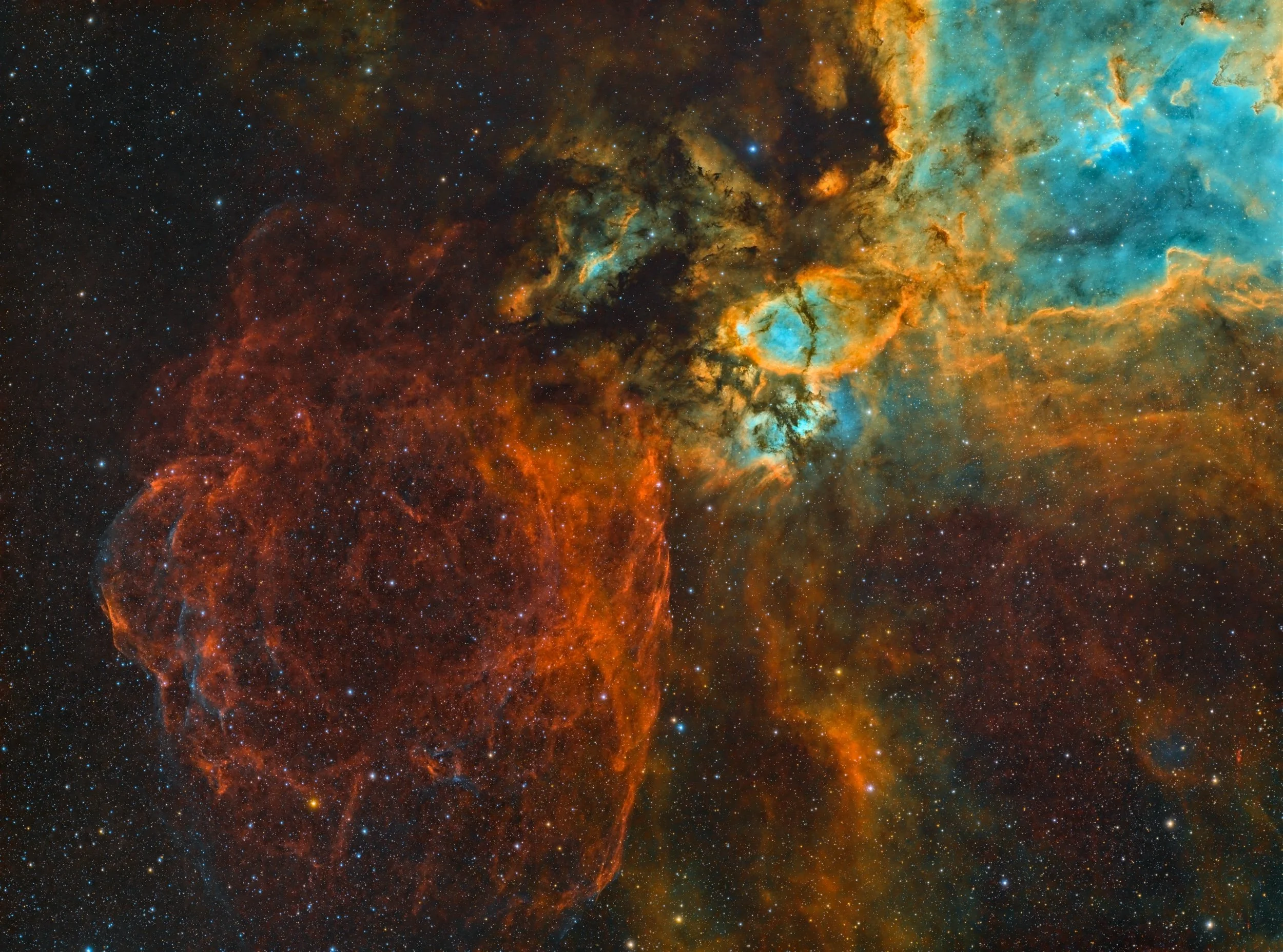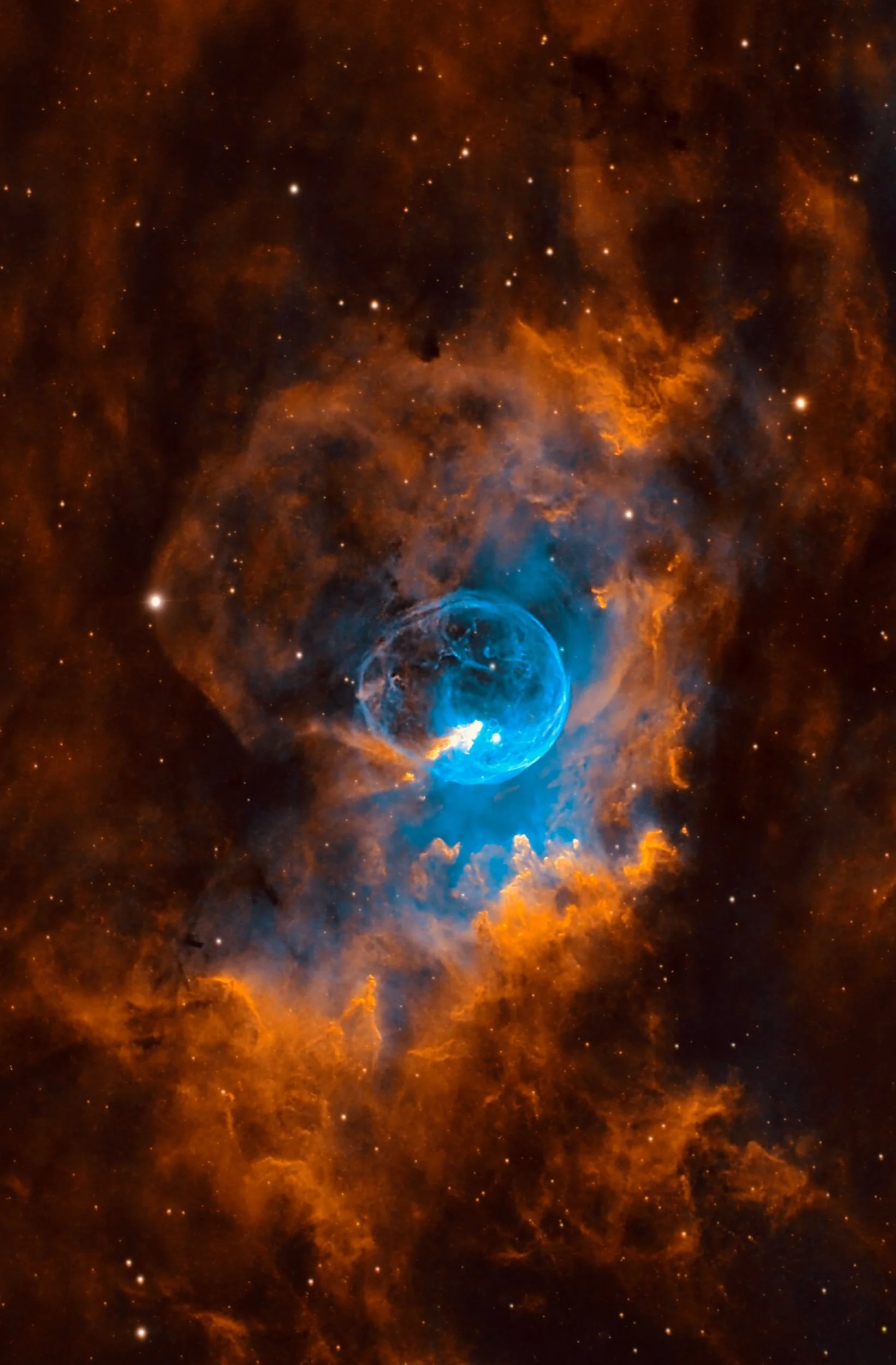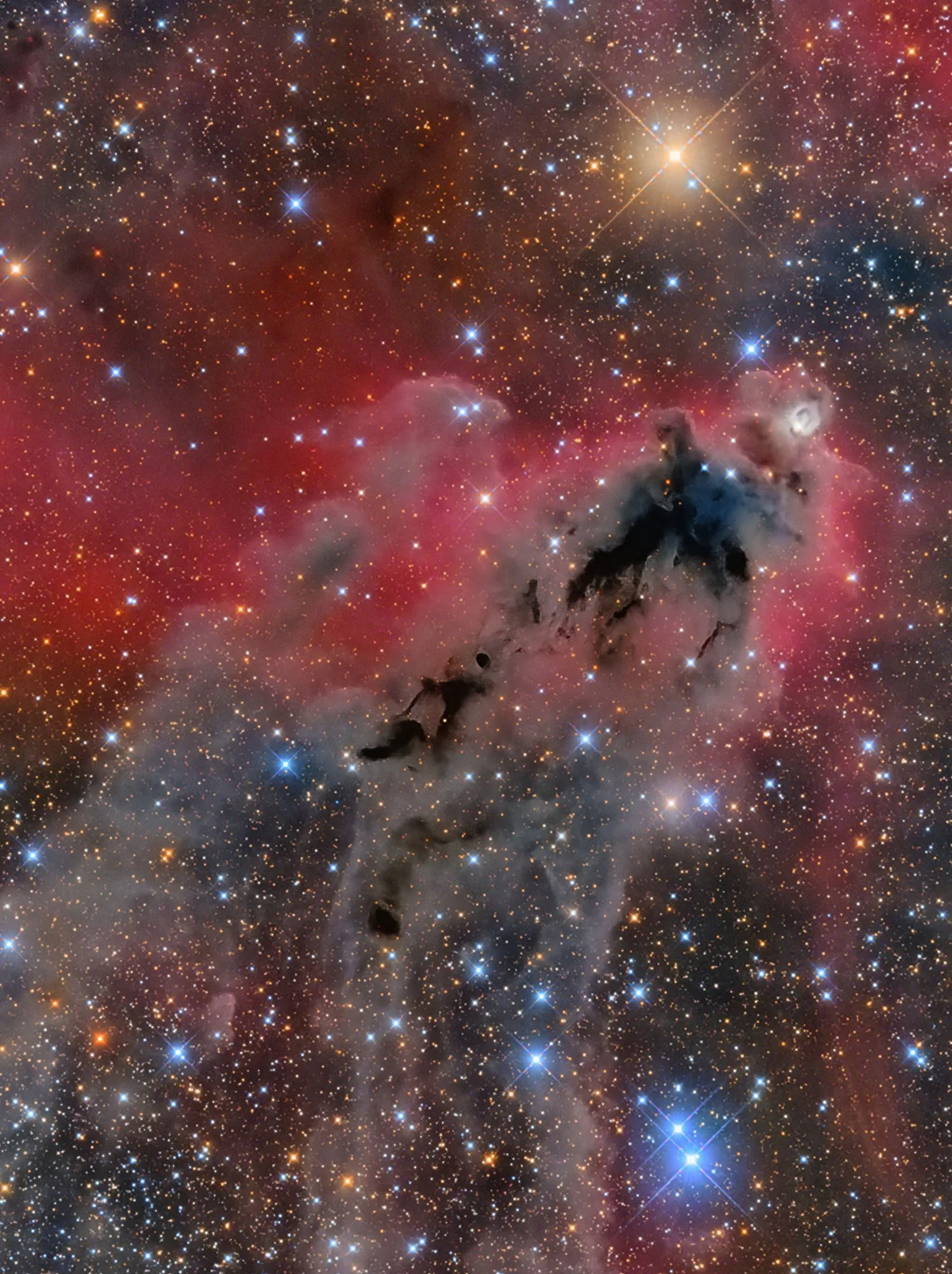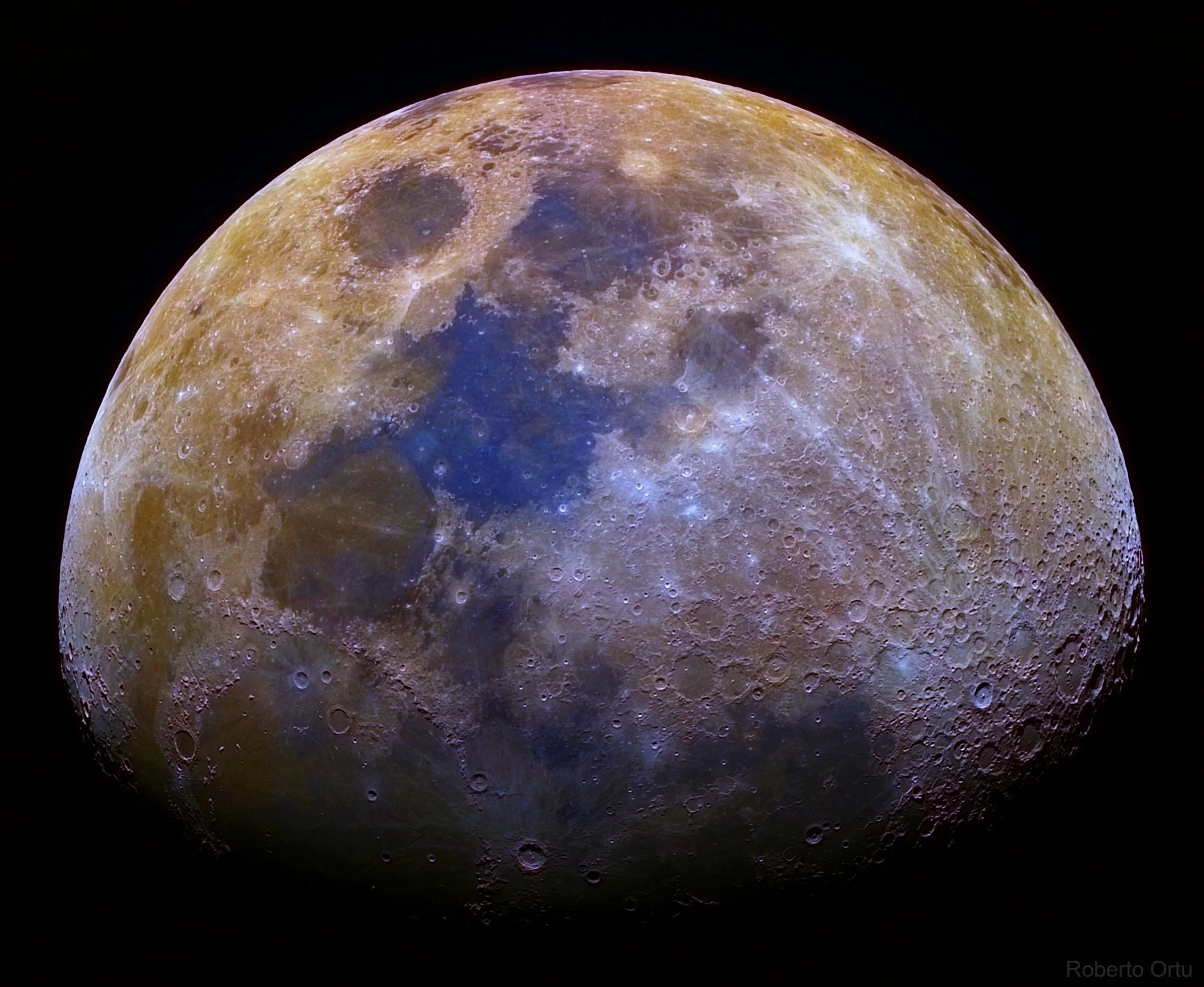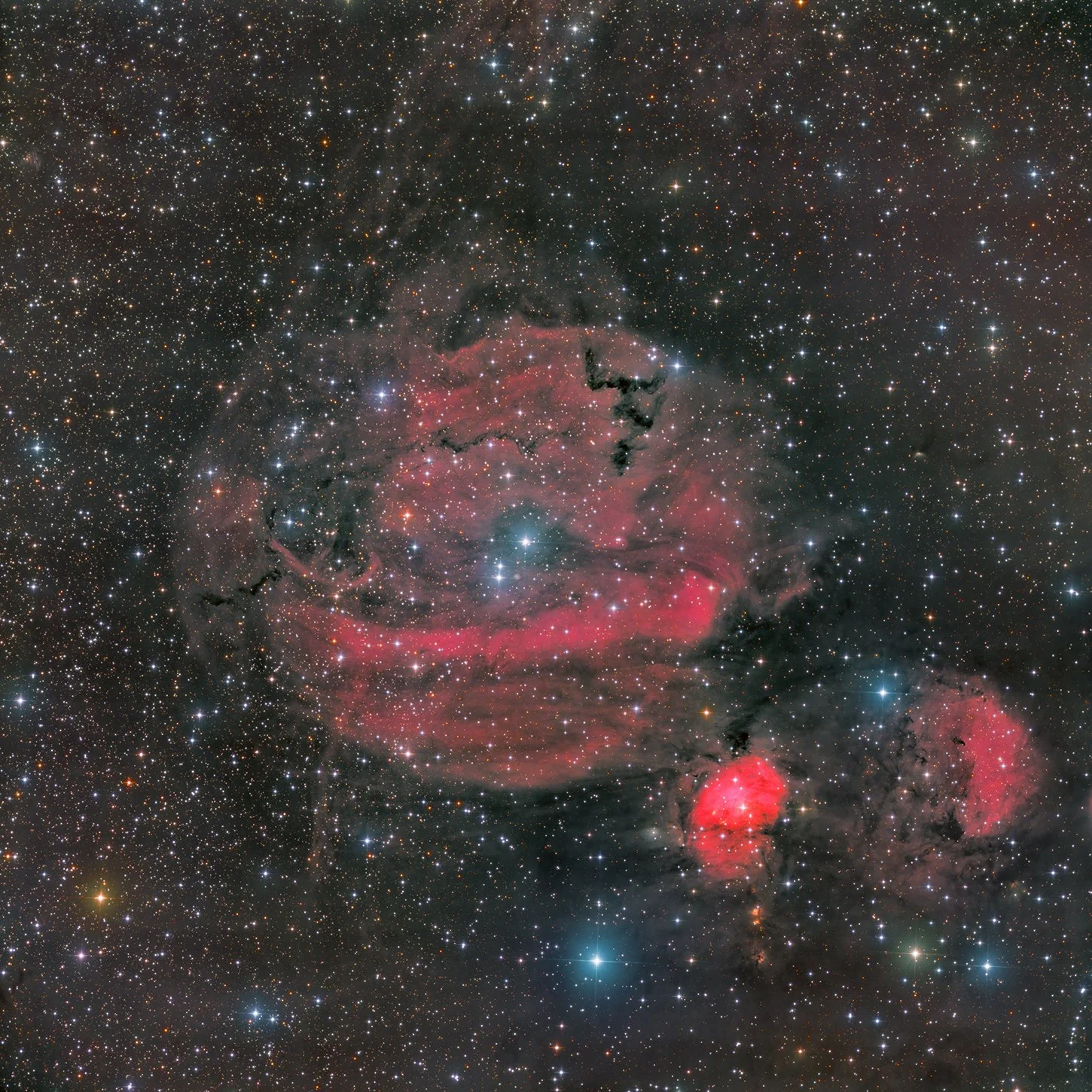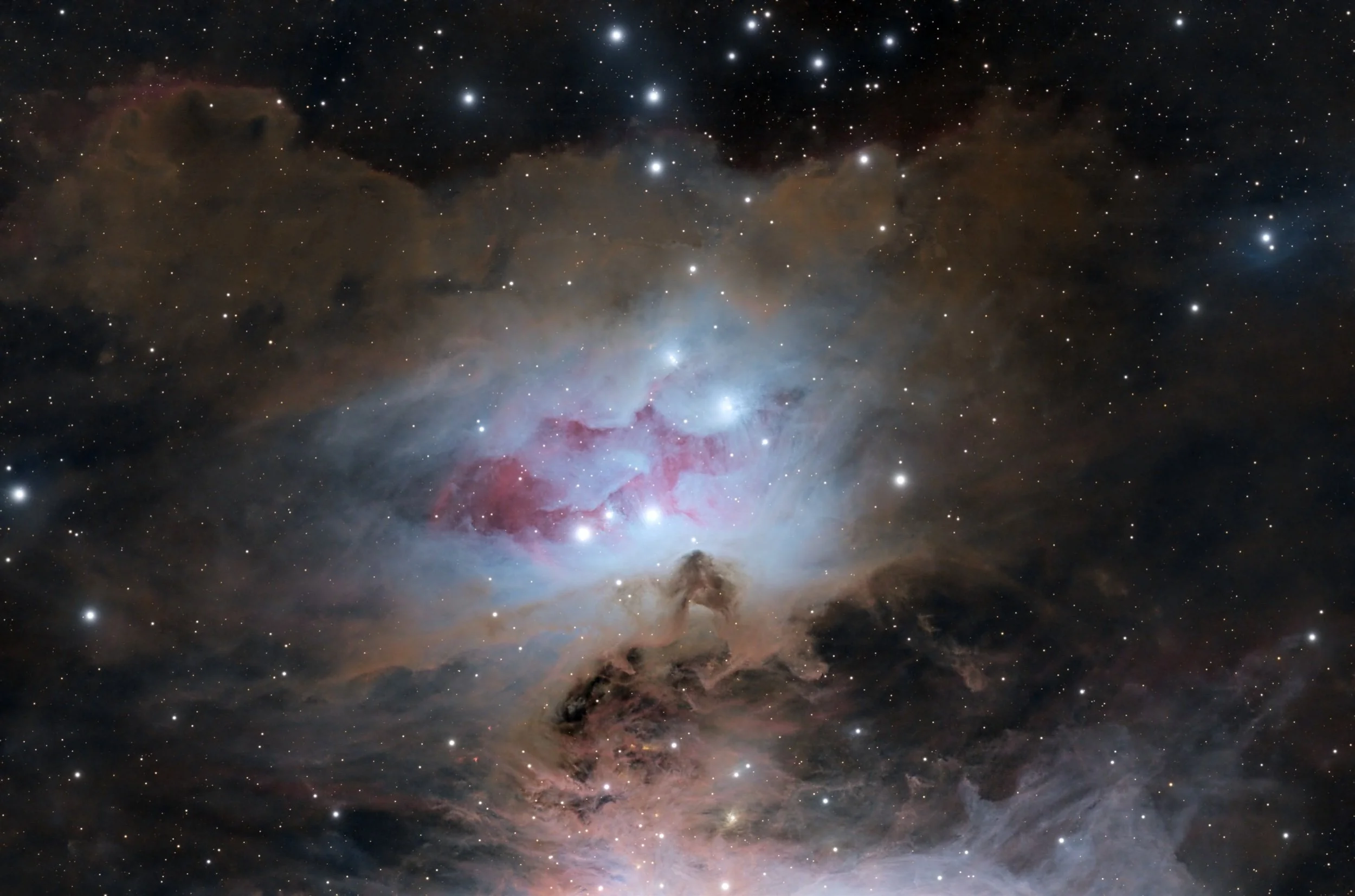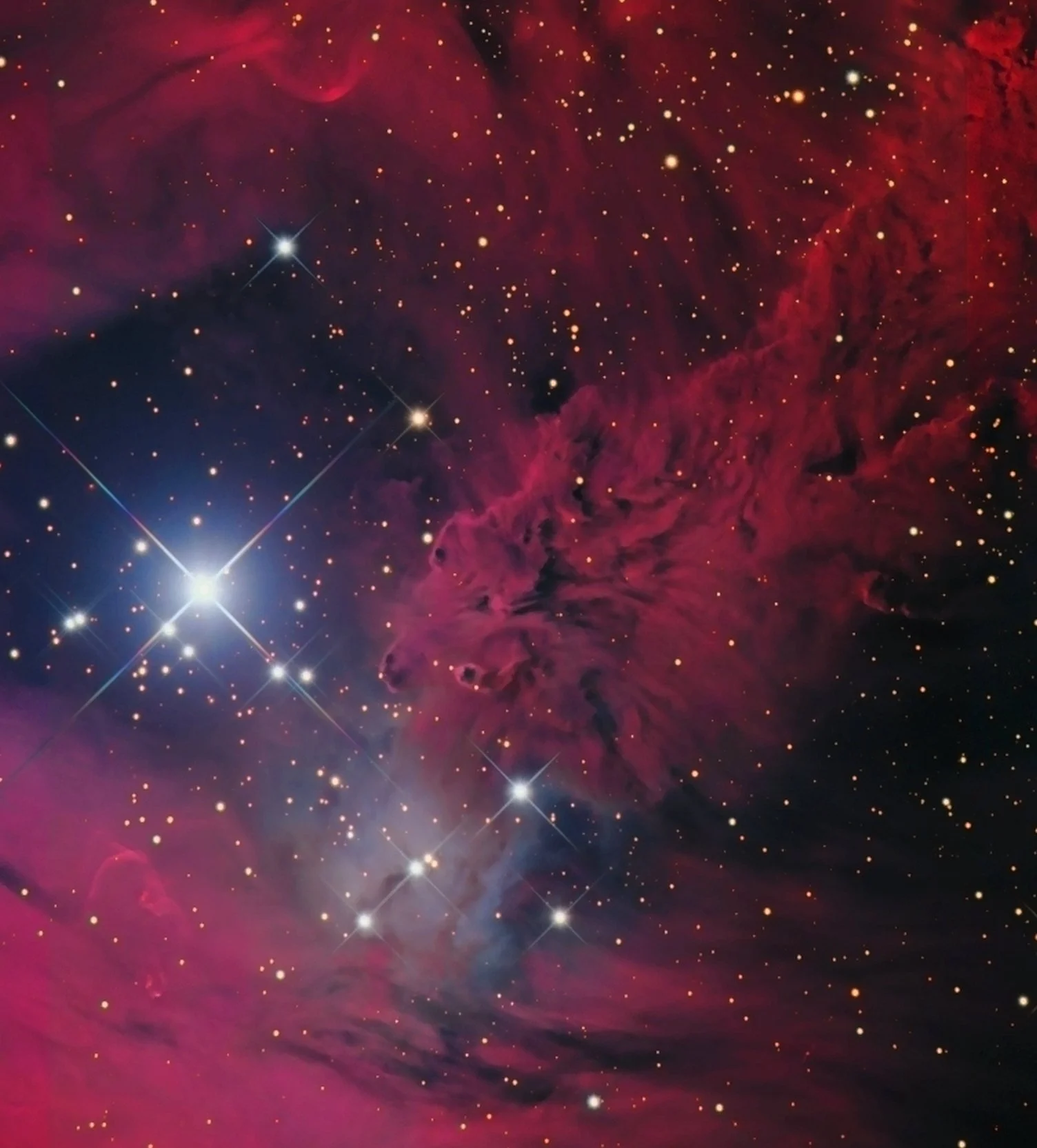
AAPOD2 Image Archives
ngc 1555 Hind's nebula
Image Description and Details : NGC 1555, sometimes known as Hind's Variable Nebula, is a variable nebula, illuminated by the star T Tauri, located in the constellation Taurus. It is also in the second Sharpless catalogas 238. It is a Herbig–Haro object. The nebula was discovered on October 11, 1852, by John Russell Hind.
RC Astrosib 20" F2.7 + camera FLI 4040
CCDautopilot+the skyX + Pixinsight + Photoshop
Total RGB=18h40mn
From E-eye Fregenal de la sierra (Spain) in remote
Copyright: Georges Chassaigne
Gassendi, an amazing crater
Image Description and Details : Gassendi, an amazing crater.
Normally, when we start astrophotography, our first target is the Moon. Our old Lua is generous because it works well even on the most modest instruments. A simple 60mm scope and a cell phone already allow for interesting photos.
But shooting the moon in high resolution requires good apertures, proper collimation and a dedicated camera, and it can be difficult work if the photo is close to the terminator.
But, in fact, it is the photos close to the terminator that reveal the good lunar photographers, as they require adequate control of light, both at the time of capture and in subsequent processing.
In this photo we have Gassendi very close to the terminator, and with the sun at an extremely low angle, the relief of the floor stands out in a dazzling way. Its rhymes are usually very evident but with the sun low we can clearly see how irregular the floor of this remarkable crater is.
Gassendi is one of the main lunar craters, with its 114 km in diameter, it is very old formed in the Nectariam period about 3.92 billion years ago.
It is an impact crater with Fractured Interior (FFC), which was modified by volcanic action after its formation, probably huge lava flows gushed through the cracks in the floor, causing numerous stress fractures to form in its interior from the reservoirs. of lava, this made it quite shallow in relation to its diameter - just 2.8 km deep.
When observed through spectroscopic analysis, the Gassendi crater has a "behavior" very different from any other lunar crater (Mikhail 1979). High-resolution studies performed in near-infrared light (Chevrel and Pinet 1990, 1992) indicated the presence of extrusive volcanic material (that is volcanic material that flows to the surface and then crystallizes) limited to the adjacent southern part of the Gassendi floor. to the floor of the Mare Humorum.
Interpretation of the data also suggested that major extrusive volcanism may have occurred in the eastern portion of the floor, as indicated by the significant presence of pyroxene, which corresponds to visible volcanic features. The western part of the crater floor, away from the geometric continuation of the western rim of Mare Humorum, is composed of rich upland material.
The difference between the west and east sides of Gassendi with intensely fractured soil could be strongly linked to the early thermal history of Mare Humorum.
I've already taken countless photos of Gassendi, but the result of this one with the sun very low really surprised me. A pleasant surprise, which shows that each photo is unique in itself and each moment is unrecoverable if we don't know how to take advantage of it.
Copyright: Astroavani
SH2-308
Image Description and Details : SH2-308 - commonly dubbed as the Dolphin-Head Nebula by astrophotographers - a HII region located near the center of the constellation Canis Major.
It is thought to have formed about 70,000 years ago by the ejection of the outer layers of the star EZ Canis Majoris.
Data credit : Aygen Erkaslan / Telescope Live
Date : 2022-2023
Location : El Sauce Obs, Chile
Scope : CDK 24" (F/6.8)
Camera : FLI PL 9000
Filters : Ha, Oiii, RGB
Integration time : 6H55
Copyright: Aygen Erkaslan
SH2-240 Spaghetti Nebula
Image Description and Details : Imaging Telescopes Or Lenses
Samyang 135mm F2.0 ED UMC
Imaging Cameras
ZWO ASI533MC Pro
Mounts
Sky-Watcher EQ6-R Pro
Filters
Optolong L-eXtreme 2"
Accessories
ZWO ASIAIR Pro
Software
Adobe Photoshop · Pleiades Astrophoto PixInsight
Guiding Telescopes Or Lenses
ZWO 30mm Mini Guider Scope
Guiding Cameras
ZWO ASI120MM
Acquisition details
Dates:
Jan. 28, 2023 · Jan. 29, 2023
Frames:
Optolong L-eXtreme 2": 60×300″(5h) ISO100 f/3.2 -10°C bin 1×1
Optolong L-eXtreme 2": 56×300″(4h 40′) (gain: 100.00) f/3.2 -10°C bin 1×1
Integration:
9h 40′
Copyright: Makrem Larnaoutn
The Boogeyman in Orion - LDN 1622 Dark Nebula
Image Description and Details : And here it is the last rendering of the Dark Nebula LDN 1622 - also dubbed the Boogeyman.
The earliest version didn't really match my requirements. Hence this redux from scratch with overall better contrast, details, colors management.
Data credit : Aygen Erkaslan
Date : lights gathered during the first three weeks of Jan 2023.
Location : own remote observatory, Spain
Scope : TOA 130
Camera: ASI 6200 mm pro
LRGB_Ha
Intégration time : 24H
Copyright: Aygen Erkaslan
NGC 2626
Image Description and Details : It has components of reflection nebula, emission nebula and dark (absorption) nebula which makes it both challenging and cool. It is located in Vela approximately 4200 light years from Earth.
The reflection nebula is primarily illuminated by a B1 star (CD-40 4432) and is ionized by the O8 quadruple star system HD 73882.
Imaged in LRGB on the Planewave CDK 700 at Observatorio El Sauce, Chile.
Image Data Acquired and preprocessed by: Mike Selby at throughlightandtime.com
Processed using Pixinsight and Photoshop.
Copyright: Mike Selby and Gowri Visweswara
Ltnf 1
Image Description and Details : LTNF 1 is an extremely faint and rarely-imaged highly-evolved planetary nebula in the constellation Ursa Major. It is a high-excitation nebula with an eclipsing binary star system (BE Ursae Majoris) at its centre which has resulted in its unusual morphology. It is around 5,000 light years from Earth. It is so transparent that galaxies can be seen through it. It was discovered by James Liebert, Richard Tweedy, Ralf Napiwotzki and Michael Fulbright in 1995. A joint project with Sven Eklund.
Scopes: APM TMB LZOS 152 Refractors and Celestron C14 Edge HD
Cameras: QSI6120wsg8 and ZWO ASI6200MM Pro
Mounts: 10Micron GM2000 HPS and 10Micron GM3000 HPS
A total of 73 hours 25 minutes (OIIILRGB)
Copyright: Copyright: Peter Goodhew, Sven Eklund
Ic2118
Image Description and Details : While i was waiting for the comet I went to “Witch's” . Photo taken from my backyard on 19 Jan 2022 in Terceira Island Azores, Portugal
Hyperstar C8 v4 390mm - Cem40EC - Asi071MC - Uv/IRCut - 100x1min
IC 2118 (also known as the Witch's Head Nebula due to its shape) is an extremely faint reflection nebula believed to be an ancient supernova remnant or gas cloud illuminated by the nearby supergiant star Rigel in the constellation of Orion.
Copyright: João Berbereia
C/2022 e3 ztf
Image Description and Details : First try with the new Pegasus Astro NYX-101 mount and my first astrophotography on a comet.
Imaging Telescope: Sky-Watcher Esprit 100ED
Imaging Cameras: QHYCCD QHY268 Pro M
Mounts: Pegasus Astro NYX-101
Filters: Baader Blue (B-CCD) 36 mm · Baader Green (G-CCD) 36 mm · Baader Red (R-CCD) 36 mm · Baader UV/IR Cut / Luminance 36 mm
Accessories: Intel NUC 10 · Pegasus Astro FlatMaster 150 · Pegasus Astro FocusCube2 · Pegasus Astro Ultimate Powerbox 2 · QHYCCD PoleMaster · QHYCCD QHYCFW3-M-US · QHYCCD QHYOAG-M
Software: Adobe Photoshop · Open PHD Guiding Project PHD2 · Pleiades Astrophoto PixInsight · Stefan Berg Nighttime Imaging 'N' Astronomy (N.I.N.A. / NINA)
Bortle:4
Exposures: All fits 60sec-Lum~27min Red~25min Green~25min Blue 25min.
Calibration Frames: Flats 10 - Darks 15 - Dark Flats 10
Copyright: Karteris Themis
IC 1805 and accompanied by this magnificent HB3 supernova remnant.
image details:
Ts optics 62/297 quintuplet
Ioptron GEM45
ZW0 asi 1600 mm pro
Pixinsight and photoshop
Antlia 3nm Narrowband H-alpha 1.25": 265×300″(22h 5′) (gain: 139.00) f/4.8 -20°C bin 1×1
Antlia 3nm Narrowband Oxygen III 1.25": 102×600″(17h) (gain: 139.00) f/4.8 -20°C bin 1×1
Antlia 3nm Narrowband Sulfur II 1.25": 102×600″(17h) (gain: 139.00) f/4.8 -20°C bin 1×1
Astronomik Deep-Sky Blue 1.25": 50×120″(1h 40′) (gain: 0.00) f/4.8 -20°C bin 1×1
Astronomik Deep-Sky Green 1.25": 50×120″(1h 40′) (gain: 0.00) f/4.8 -20°C bin 1×1
Astronomik Deep-Sky Red 1.25": 50×120″(1h 40′) (gain: 0.00) f/4.8 -20°C bin 1×1
Intégration:
61h 5′
Copyright: PUIG Nicolas
Vela Supernova Remnant
Image Description and Details : Vela Supernova Remnant
This is one of my favourite regions.
7 hours of 180s and 300s subs taken over 3 nights. (Shorter subs on a windy night).
Taken from my back yard here in Western Australia, Bortle 2 skies.
Equipment: Askar ACL200 with quad band filter, Skywatcher EQ6-R mount, ZWO ASI294MC-pro camera. ZWO ASIAIR-plus
Processed with Astropixel processor and Pixinsight
Copyright: Copyright: Michelle Bennett
Gum 37 / RCW 54c & NGC 3572 Stars Cluster
Image Description and Details : The target features glowing gas and dark dust clouds alongside the young stars of NGC 3572, a beautiful emission nebula and a star cluster located in the southern sky in the constellation Carina.
Image acquisition information:
Location: El Sauce, Chile
Scope: CDK 24" (F/6.8)
Camera: QHY 600m
Sii, Ha, Oiii, respectively each 600s
Intégration time : 5h
Copyright: Aygen Erkaslan / Telescope Live
SH2-162 - The Bubble Nebula
Image Description and Details : SH2-162 - The Bubble Nebula.
An H II region emission nebula in the constellation Cassiopeia, about 11,000 light years away. The "bubble" is created by the stellar wind from a massive hot, 8.7 magnitude young central star, SAO 20575.
Celestron 14” Edge HD with .7x reducer at F/8
Celestron OAG and a ZWO 174mm guide camera
Ioptron CEM 120 mount
ZWO 2600MM Pro cooled to -10° / gain 100.
ZWO ASIAIR pro+
ZWO EAF focuser
Chroma 3nm filters with ZWO 7x36mm EFW
Processed in Pixinsight.
Shot from my backyard, bortle 8.
Sii - 5 min subs x 46 = 4 hrs.
Ha - 5 min subs x 58 = 5 hrs.
Oiii - 5 min subs x 43 = 4 hrs.
Total integration time = 13 hrs.
Copyright: Richard McInnis
Heckathorn-Fesen-Gull 1 (HFG1) aka PK 136+05
Image Description and Details : HFG-1 was discoverd in 1982 by Heckathorn, Fesen and Gull. Its central star is actually a binary star system, V664 Cas (magnitude 14) that is moving through our galaxy. V664 Cas consists of a white dwarf star and a large red giant, rotating around their centre of gravity every 14 hours. As HFG 1 moves through the ISM a bowshock is produced in front of it as well as a red trail of gas in its wake. Outer diameter about 15 arcmin.
HOO palette
82h Ha
36h Oiii
and some RGB for the stars.
Equipment:
Celestron EdgeHD14"
ZWO asi6200mm
Chroma 3nm
10Micron GM3000 HPSII
Scopedome 3M
Imaged from E-eye, Spain
Copyright: Sven Eklund
Dark Pillars in Orion
Image Description and Details : LDN 1622, also referred to as the Boogeyman Nebula, is a dark nebula that appears against the glowing Hydrogen of Barnard’s Loop in the constellation of Orion. However, LDN 1622 is thought to be much closer than Orion's more famous nebulae, perhaps only 500 light-years away. Its foreboding appearance lends this dark nebula its popular name, the Boogeyman Nebula.
Data:
210x120” (7h), gain 120, -20°
Darks, Flats, Dark Flats
Bortle 3 (21.86)
Gear:
Sharpstar 13028HNT f2.8
iOptron GEM45
ZWO ASI294MC Pro
ZWO ASiair Plus
ZWO ASI174MM Mini (guide)
ZWO OAG-L
ZWO EAF
Post:
DeepSkyStacker
PixInsight
RC-Astro BXT, NXT, SXT
Adobe Photoshop
Copyright: Joshua Carter
A colorful Moon mosaic
Image Description and Details : This is my lunar mosaic of the waxing gibbous mineral Moon (9.50 days old).
Technical data:
Celestron 114/910 Newton
Planetary camera QHY5L-II-C
Filter UV IR cut
Software: Sharpcap 3.2, Autostakkert! 3.1.4, Astrosurface T5-TITANIA, Autostitch, GIMP
Location: Cabras, Sardinia, Italy
Copyright: Copyright: Roberto Ortu
sh2-232
Image Description and Details : Sh2-232 (centre) and Sh2-235 (lower left) are large, faint regions of Ha-nebulosity in the constellation Auriga. But they aren’t the only objects in the image. The small oval structure just left of centre of Sh2-232 is a planetary nebula, PN G173.5+03.2. Another faint planetary appears as a small yellowish haze around a star just above Sh2-235.
Astrosib RC 20" F2.7 +camera FLI Kepler 4040 cmos
Total Hargb=19h05
ccdautopilot+the skyX + Pixinsight + Photoshop
From Fregenal de la sierra(Spain) in remote
Copyright: Georges Chassaigne
Running Man NGC 1975
Image Description and Details : There is a grouping of reflection nebulae in Orion - NGC 1977, NGC 1975, and NGC 1973 - usually overlooked in favor of the substantial glow from the nearby stellar nursery better known as the Orion Nebula. Found along Orion's sword just north of the bright Orion Nebula complex, these reflection nebulae are also associated with Orion's giant molecular cloud about 1,500 light-years away, but are dominated by the characteristic blue color of interstellar dust reflecting light from hot young stars.
Running Man
Starry Nights Ranch, Basinger FL (Bortle 3)
Takahashi TOA-130NFB with guiding
iOptron CEM70G
ASI2600MC
57 x 300 seconds
20 Darks
20 Flats
20 Flat Darks
Data acquisition: NINA
Data processing: Pixinsight
Copyright: Copyright:Daniel Stern
Fox Fur Nebula
Image Description and Details : ASA Astrosysteme ASA20NG-OK3 f 3,6, FLI PL16083
Frames: H-Alpha: 35×1200″(11h 40′), Lum: 60×600″(10h), RGB: 75×600″(12h 30′). Integration: 34h 10′.
The Fox Fur Nebula is a nebula (a formation of gas and dust) located in the constellation of Monoceros not far off the right arm of Orion and included in the NGC 2264 Region.
The image is a close-up of a small section of a much larger complex, generally known as the Christmas Tree cluster. The Cone Nebula is also a part of this same cloud.
The red regions of this nebula are caused by hydrogen gas that has been stimulated to emit its own light by the copious ultraviolet radiation coming from the hot, blue stars of the cluster. The blue areas shine by a different process: they are mainly dust clouds that reflect the bluish light of the same stars.
Its popular name arises because the nebula looks like the head of a stole made from the fur of a red fox.
Copyright: Chilescope / Ruben Barbosa
Molecular Clouds in Chameleon
Image Description and Details : This framing shows an area of star formation (one of the closest we have from earth, only 500ly) in the constellation of Chameleon.
The brightest nebula (blue nebula in the upper part) is IC2631, a reflection nebula.
The blue nebula below is Ced111 while the beautiful C-shaped yellowish nebula close to it is Ced110.
This is a 9h integration photograpeh in 2 nights (16th and 19th, January, 2023).
🗓 January, 19th. 2023
📍 Giruá, RS, Brazil. Bortle 4.
🔭 FotonAstro Astropipe 200MM F4 Newtonian Astrograph
📷 asi2600mc
🕹 ZWO AM5.
🕶 No filters (UV/IR built in)
- 221 x 150s (9,2h)
🧑💻 pixinsight, photoshop
Copyright: Martin Konrat

